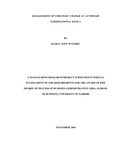| dc.contributor.author | Kamau, Judy W | |
| dc.date.accessioned | 2013-03-19T08:00:37Z | |
| dc.date.issued | 2010 | |
| dc.identifier.citation | Masters in Business Administration | en |
| dc.identifier.uri | http://erepository.uonbi.ac.ke:8080/xmlui/handle/123456789/14577 | |
| dc.description.abstract | In the last decade there has been has been an acceleration of the magnitude and pace of
change across the globe. These changes, whether political, economic, social and
technological have not spared Kenya. The approach which Kenyan companies use to
initiate and implement strategic changes is not clear. This study aimed at establishing the
challenges of change programme at ActionAid. The study objectives were: to evaluate
the change management process in the light of the models of change management and to
determine the effect of organizational change on organizational performance and identify
the challenges faced in managing the change program at ActionAid International Kenya.
The study used a case study method. Primary and secondary sources of information were
used in the collection of data. The primary data was obtained from interactive personal
interviews with senior management staff of ActionAid International Kenya. A content
analysis was used to analyze the data.
The study established that the change management process at ActionAid International
Kenya (AAIK) begins with goal setting and objectives. A variety of objectives are set in
ActionAid International Kenya (AAIK). The study found out that the challenges faced in
managing the change program at ActionAid International Kenya are due to restructuring
of the organization.
From the study findings, the change program at ActionAid follows a planned approach.
The findings indicate that AAIK has adopted new technology: HIVE-internatio
VI for most staff and creation of mobile offices. The study concluded that changes in the
organisation have preceded growth strategy. This explains why ActionAid has undergone
structural changes within a very short period of time that is in less than two years. The
study recommended that there is need for the AAIK’s management to take a more
proactive approach to managing change within the organisation.
Annual planning has an operational focus and is concerned primarily with concrete goal
setting and scheduling of specific tasks to meet these goals. Strategic planning gives
explicit recognition to the organizations outside environment and places an emphasis on
the organization’s strategic advantage in meeting the contingencies in the environment.
The AAIK’s management can build upon their experience in long term strategic change
planning, environmental scanning, goal setting and performance evaluation to develop a
strategic plan more practical than an annual plan. There is also need for a structured
planning process with designated and sequenced activities such as brainstorming, small
group work and listing, summarizing and prioritizing which makes it possible for
everyone in attendance to participate fully. This involvement throughout the process will
ensure that those who have major responsibilities to carry out the plan understand the
plan and the reasons behind it. Employee involvement in the strategic change planning
process can contribute greatly to employee commitment to mutual goals and a sense of
organization unity. | en |
| dc.description.sponsorship | The University of Nairobi | en |
| dc.language.iso | en | en |
| dc.subject | Actionaid International Kenya | en |
| dc.subject | Management of strategic change | en |
| dc.title | Management of strategic change at action-aid International Kenya | en |
| dc.type | Thesis | en |
| local.embargo.terms | 6 months | en |
| local.publisher | School of Business | en |

